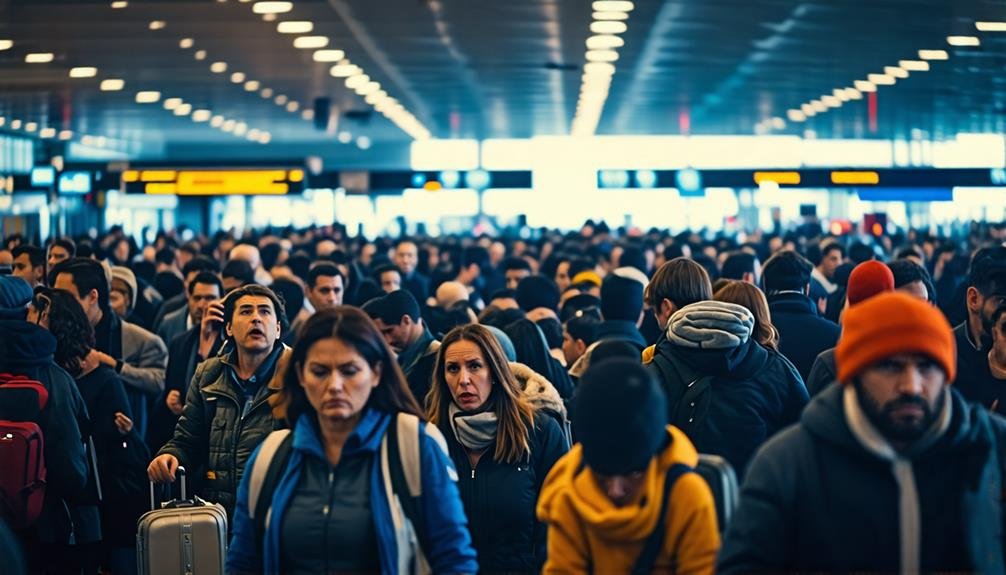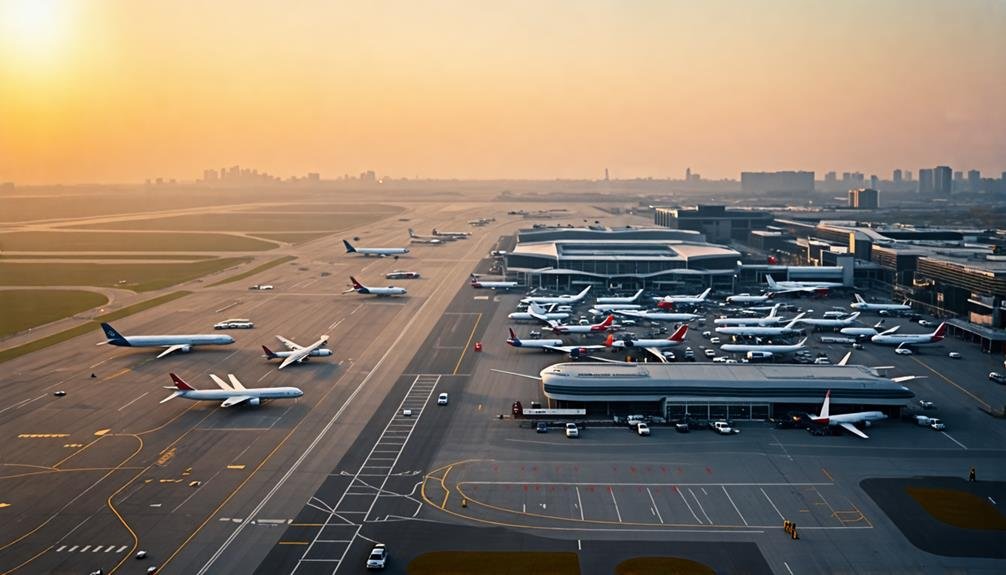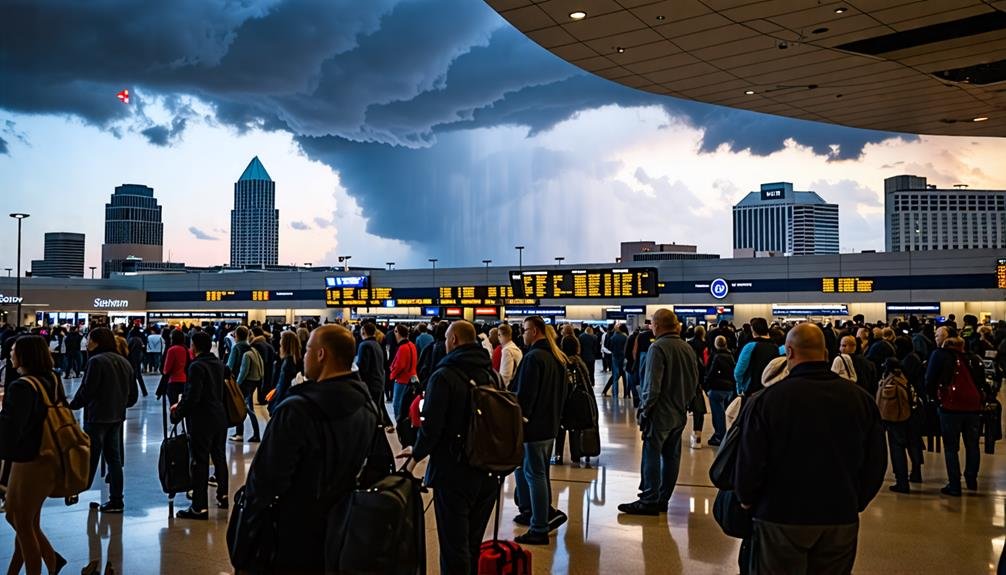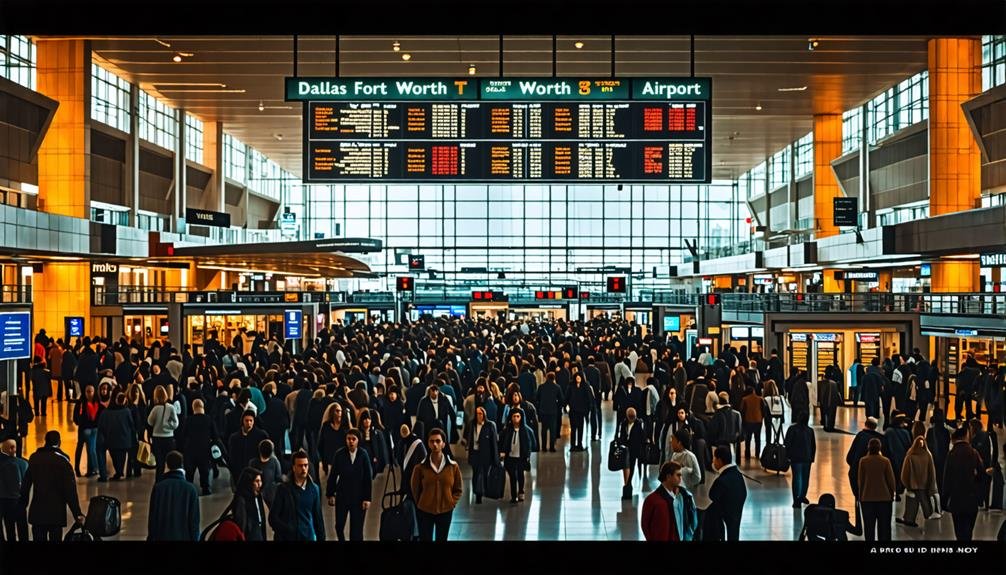Dallas-Fort Worth Airport is frequently noted as America's worst due to its exceptionally high flight disruption rates, with over 45% of flights experiencing delays. This situation is worsened by severe weather conditions, especially thunderstorms, which impact operations and require ground crew sheltering. Additionally, the airport's vast size complicates navigation, leading to passenger confusion and extended wait times. Surveys reveal significant traveler dissatisfaction, attributed to outdated facilities and limited accessibility. Such challenges, along with high passenger traffic, contribute to operational inefficiencies. Understanding these dynamics reveals the greater context behind DFW's reputation and ongoing efforts for improvements.
Bad Reputation for Flight Disruptions
Dallas Fort Worth International Airport (DFW) has developed a troubling reputation for frequent travel disruptions, with over 45% of its flights facing delays. This alarming figure ranks DFW among the least reliable airports in the United States, particularly for passengers prioritizing efficiency and dependable service. The high volume of air traffic at DFW, where 60% of travelers connect rather than fly directly, worsens the situation.
In just 18 months, DFW faced 66,105 flight delays, averaging 90 minutes each. Such interruptions frustrate passengers and contribute to a negative image of the Dallas-Fort Worth airport. In May 2024, severe storms caused over 900 delays, underscoring the airport's susceptibility to weather-related challenges.
These figures highlight that while DFW serves as a key travel hub, its operational issues can lead to significant inconvenience and dissatisfaction for travelers. As passengers seek seamless journeys, the ongoing delays at DFW remain a pressing concern within the aviation industry.
Causes of Delays at DFW
Frequent delays at Dallas/Fort Worth International Airport (DFW) stem from adverse weather conditions, particularly thunderstorms, which disrupt flight schedules. The Dallas region experiences volatile weather, averaging 46 days of thunderstorms each year. In May 2024, DFW recorded the third-highest number of thunderstorm days, leading to significant operational disruptions.
Federal Aviation Administration (FAA) regulations require airport personnel to seek shelter during lightning events, which intensifies delays. The high occurrence of inclement weather creates a difficult environment for flight operations. Thunderstorms cause not only direct delays but also ripple effects that impact connecting flights and overall airport efficiency.
Additionally, DFW's massive size, as the second largest airport in the United States, complicates matters. Increased passenger traffic can exceed operational capacity, especially when adverse weather coincides with peak travel times. As travelers navigate a vast network of terminals, the effects of weather-related disruptions are amplified, emphasizing the need for strong contingency plans to address these issues. Understanding these elements is essential for anyone looking to comprehend the complexities behind DFW's flight delays.
Survey Results and Traveler Complaints

Survey feedback reveals concerns about Dallas/Fort Worth International Airport (DFW), with 14% of participants indicating dissatisfaction with the facility's offerings. This discontent aligns with various traveler reviews, showcasing a consistent pattern of issues. Primary areas of concern include:
- The airport's vast expanse, complicating navigation for passengers.
- The outdated terminal architecture, resulting in operational inefficiencies.
- The limited presence of elevators and other accessibility features.
Travelers often describe their DFW experiences as frustrating due to its large layout and aging infrastructure. The facility has struggled to accommodate the increasing passenger volume, leading to lengthy walks between gates and challenges in locating amenities. These factors contribute to DFW's reputation as one of the least favored airports in the United States. The mix of traveler dissatisfaction and infrastructural hurdles paints a concerning picture for those desiring a smooth airport experience. As the airline industry evolves, addressing these challenges will be essential for enhancing traveler satisfaction and operational effectiveness at DFW.
DFW's Operational Challenges
Dallas/Fort Worth International Airport (DFW) faces operational hurdles due to its vast size and high passenger traffic. As the second largest airport in the United States, DFW handles millions of travelers each day, which burdens its operational capabilities. The airport's design, featuring extensive terminals, often confuses passengers, making boarding challenging and heightening the chances of delays.
Additionally, DFW functions as a crucial hub for several airlines, resulting in a significant number of connecting flights. This interconnected system can exacerbate the impact of a single delay, influencing many travelers and flights throughout the network. Frequent weather disruptions, particularly thunderstorms, further amplify DFW's operational challenges.
Impact of Airport Size

The vast expanse of Dallas/Fort Worth International Airport (DFW) significantly influences traveler satisfaction and operational workflow, making navigation challenging and leading to delays. As the second largest airport in the United States, its extensive design presents distinct hurdles for passengers. The following aspects illustrate how DFW's size impacts its functionality:
- Navigation Challenges: The extensive terminals can bewilder travelers, resulting in longer walking distances and the risk of missing flights. Many passengers, especially those unfamiliar with DFW, find the layout intimidating.
- Traffic Congestion: High passenger traffic intensifies congestion, causing extended wait times at security checkpoints and boarding gates. The large influx of travelers can create bottlenecks, disrupting the entire scheduling system.
- Operational Challenges: With an average of 66,105 flight delays recorded over 18 months, DFW's size often leads to operational difficulties. Increased traffic demands can impede timely departures and arrivals, complicating an already hectic atmosphere.
Weather Patterns Affecting Flights
Weather patterns greatly influence flight operations at Dallas-Fort Worth International Airport, particularly due to the region's frequent thunderstorms from March to August. Lightning safety regulations necessitate that airport staff seek shelter during storm events, which can lead to operational delays. Moreover, the seasonal nature of these weather disturbances often exacerbates disruptions, impacting both flight schedules and passenger experiences.
Frequent Thunderstorm Days
Frequent thunderstorms disrupt flight operations at Dallas-Fort Worth International Airport (DFW), especially during peak storm months from March to August. This tumultuous weather pattern significantly impacts airline schedules, resulting in increased delays and cancellations. DFW experiences an average of 46 thunderstorm days each year, with May 2024 recording exceptionally high storm activity.
The consequences of these thunderstorms can be summarized in three areas:
- Flight Delays: Thunderstorms often cause lengthy flight delays, as airlines, including American Airlines and Southwest Airlines, must comply with stringent safety protocols, leading to a domino effect on subsequent flights.
- Operational Challenges: The vastness of DFW and its high traffic volume intensify disruptions. With thousands of flights operating daily, each delay exacerbates the dilemma for both airlines and travelers.
- Passenger Experience: Travelers encounter frustration due to uncertainty surrounding departure and arrival times, making the airport experience less enjoyable and more stressful.
Lightning Safety Regulations
Thunderstorms frequently impact the Dallas-Fort Worth area, compelling airport staff to seek refuge indoors due to stringent lightning safety regulations. The Federal Aviation Administration (FAA) enforces these safety measures to ensure the protection of personnel and travelers alike. When lightning strikes are detected within a defined perimeter of Dallas/Fort Worth International Airport, ground operations must immediately halt, prompting workers to evacuate the tarmac and other vulnerable zones.
This abrupt cessation disrupts operational efficiency significantly, resulting in delays as aircraft cannot be serviced, boarded, or deplaned. As a result, passengers may face prolonged wait times, which can disrupt connecting flights, further complicating the airport's reputation for efficiency.
With an average of 46 thunderstorm days each year in the Dallas region, these interruptions are common. The interplay of operational hurdles and adherence to safety regulations creates a situation where, despite a commitment to seamless travel, the realities of weather patterns and safety measures often clash, leaving travelers frustrated by delays at one of the busiest airports globally.
Seasonal Weather Impact
The Dallas-Fort Worth area experiences significant seasonal weather changes, which impact flight operations at Dallas/Fort Worth International Airport (DFW). The unpredictable weather patterns result in frequent disruptions, especially during spring and summer. Three main weather-related issues affect these operations:
- Frequent Thunderstorms: From March to August, DFW encounters numerous thunderstorms, leading to immediate flight delays and cancellations.
- Increased Lightning Activity: Lightning during storms requires ground crews to seek shelter, complicating operations and delaying departures.
- Severe Weather Events: The region faces severe weather, including heavy rainfall and hail, which can greatly affect runway access and safety measures.
These challenges create a tough environment for airlines and passengers. Consequently, DFW often experiences a high rate of flight disruptions, contributing to its low ranking among American airports. The unpredictable nature of Texas weather calls for flexible strategies to reduce the impact on flight schedules and enhance the travel experience.
Historical Flight Disruption Data

Analyzing historical flight disruption data reveals a concerning trend at Dallas-Fort Worth International Airport (DFW). The frequency of delays significantly impacts traveler experiences. Between January 2022 and June 2023, DFW recorded 66,105 flight delays, averaging 90 minutes per incident. This positions DFW as a notable outlier, with over 45% of its flights experiencing disruptions.
The Bureau of Transportation Statistics ranks DFW among the nation's top airports for delays, highlighting systemic issues contributing to this reputation. DFW serves as a crucial hub for more than 60% of travelers connecting through, amplifying the delays' impact on a broader network of passengers.
Historical data underscores challenges at DFW, including high air traffic volumes and frequent weather-related disruptions. As travelers seek reliable transit experiences, these patterns raise concerns about operational efficiency and overall traveler satisfaction. This situation emphasizes the need for a reevaluation of management strategies to foster more seamless journeys for passengers.
Future Prospects for DFW
The future prospects for Dallas-Fort Worth International Airport (DFW) depend on overcoming operational hurdles and enhancing traveler experiences as air traffic demands increase. To tackle these challenges, DFW must focus on three key areas:
- Infrastructure Enhancements: Upgrading terminal layouts and expanding facilities will help ease passenger movement and reduce delays. Investments in technology, such as automated check-in kiosks and biometric screening, can improve operational efficiency.
- Weather Management Techniques: Implementing proactive strategies to handle weather-related disruptions is crucial. This includes adopting advanced forecasting systems and establishing effective communication protocols during inclement weather.
- Enhanced Passenger Experience: Improving service quality at DFW, with features like modern amenities and clear signage, will create a more enjoyable travel atmosphere. A seamless experience can help counteract negative perceptions and increase customer satisfaction.









































